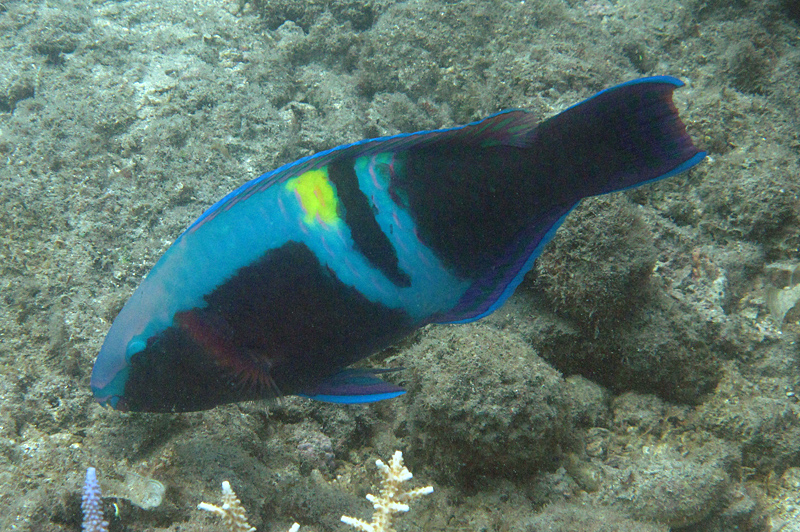- Classification
- ACTINOPTERYGII
- PERCIFORMES
- LABRIDAE
- Scarus
- schlegeli
Schlegel's Parrotfish, Scarus schlegeli (Bleeker 1861)

A male (terminal phase) Schlegel's Parrotfish, Scarus schlegeli, at Lizard Island, Great Barrier Reef, Queensland. Source: Andy Lewis / Lizard Island Field Guide. License: CC by Attribution
Summary:
Males are dark bluish to purple with a pale blue on the upper body anteriorly, and a yellow-edged vertical blue line through the midsection. Females (initial phase) are dark brownish with 4-5 pale chevron-shaped bands on the body.
Cite this page as:
Dianne J. Bray, Scarus schlegeli in Fishes of Australia, accessed 20 Apr 2024, https://fishesofaustralia.net.au/home/species/401
Schlegel's Parrotfish, Scarus schlegeli (Bleeker 1861)
References
Bonaldo, R.M. 2011. The ecosystem role of parrotfishes on coral reefs, PhD thesis, James Cook University.
Choat, J.H., K.D. Clements & W.D. Robbins. 2002. The tropic status of herbivorous fishes on coral reefs. 1. Dietary analyses. Marine Biology 140: 613-623.
Choat, J.H., K.D. Clements & W.D. Robbins, 2004. The trophic status of herbivorous fishes on coral reefs 2: Food processing modes and trophodynamics,Marine Biology 145: 445-454.
Choat, J.H., O.S. Klanten, L. Van Herwerden, D.R. Robertson & K.D. Clements, 2012. Patterns and processes in the evolutionary history of parrotfishes (Family Labridae). Biological Journal of the Linnean Society 107: 529-557.
Choat, J.H. & J.E. Randall, 1985. A review of the parrotfishes (family Scaridae) of the Great Barrier Reef of Australia with description of a new species Records of the Australian Museum 38(4): 175-239.
Choat, J.H. & D.R. Robertson. 2002. Chapter 3: Age-based studies on coral reef fishes in: Coral Reef Fishes. Sale, P. (ed.). Academic Press.
Crossman, D.J., J.H. Choat & K.D. Clements, 2005. Nutritional ecology of nominally herbivorous fishes on coral reefs,Marine Ecology Progress Series 296: 129-142.
Dudgeon, C.L., N. Gust & D. Blair, 2000. No apparent genetic basis to demographic differences in scarid fishes across continental shelf of the Great Barrier Reef, Marine Biology 137: 1059-1066.
Eckes, M.J., U.E. Siebeck, S. Dove & A.S. Grutter, 2008. Ultraviolet sunscreens in reef fish mucus, Marine Ecology Progress Series 353: 201-211.
Fulton, C.J., J.L. Johansen & J.F. Steffensen, 2013. Energetic extremes in aquatic locomotion by coral reef fishes.,PLoS ONE 8(1): e54033.
Fulton, C.J., J.L. Johansen & J.F. Steffensen, 2013. Energetic extremes in aquatic locomotion by coral reef fishes,PLoS ONE 8(1): e54033.
Gust, N. 2002. Scarid biomass on the northern Great Barrier Reef: the influence of exposure, depth and substrata,Environmental Biology of Fishes 64: 353-366.
Gust, N. 2004. Variation in the population biology of protogynous coral reef fishes over tens of kilometres. Canadian Journal of Fisheries and Aquatic Sciences 61: 205-218.
Gust, N., J.H. Choat & J.L. Ackerman. 2002. Demographic plasticity in tropical reef fishes. Marine Biology 140: 1039-1051.
Hoey, A.S. 2010. The ecosystem role of macroalgal browsing fishes on coral reefs., PhD thesis, James Cook University.
Smith, L.L., J.L. Fessler, M.E. Alfaro, J.T. Streelman & M.W. Westneat. 2008. Phylogenetic relationships and the evolution of regulatory gene sequences in the parrotfishes. Molecular Phylogenetics and Evolution 49: 136-152.
Wainwright, P.C., D.R. Bellwood, M.W. Westneat, J.R. Grubich & A.S. Hoey. 2004. A functional morphospace for the skull of labrid fishes: patterns of diversity in a complex biomechanical system.Biological Journal of the Linnean Society 82: 1-25.














